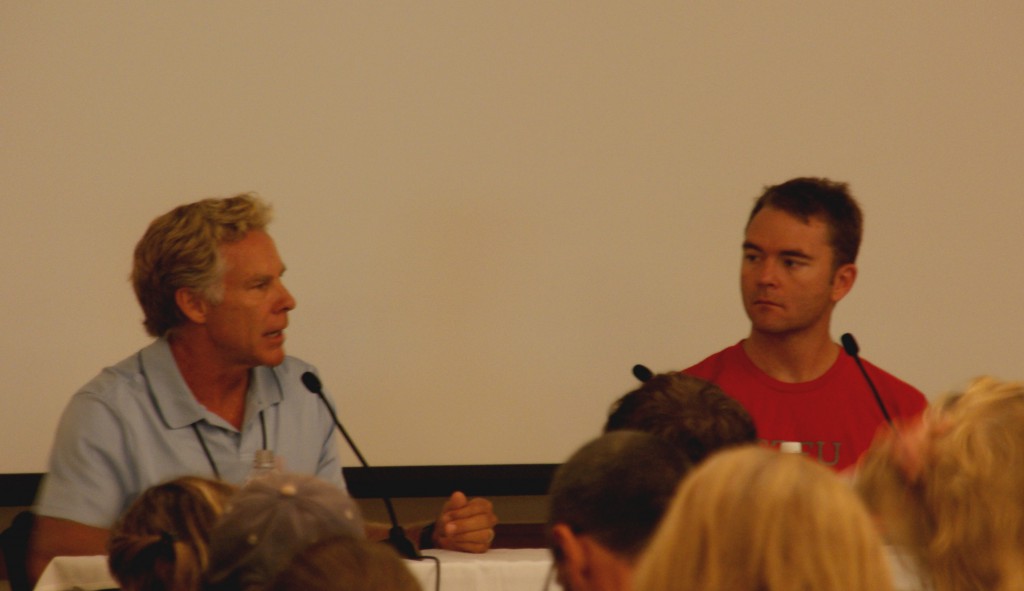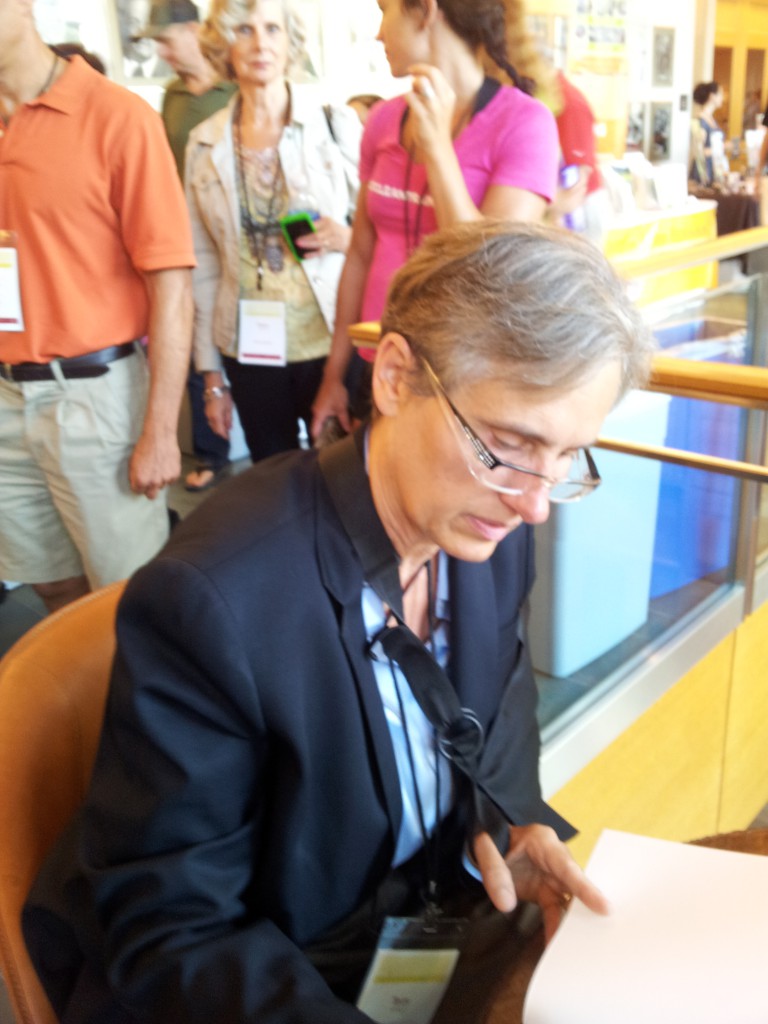AHS Day 3: All Good Things Must Come to an End
by lisa | 21 August 2012 19:00
Day 3 of the symposiusm was an action packed, star studded event filled with many great presentations. You can read about Day 1 here and Day 2 here in case you missed them.
Again there were two tracks to choose from so I had to make some hard decisions about which speakers to listen to. I missed out on the lectures related to cancer and epilepsy, and some of the end of the day presentations (most notably the one by Denise Minger). I’ve enjoyed reading other people’s impressions of what I missed and will certainly be watching the videos when they come out.
Even though I was tired form the fabulous Sustainable Feast from the night before, there was no sleeping in for me because two of the biggest names in Paleo were on for the first presentation of the day.
Mark Sisson and Robb Wolf
That’s right…Mark Sisson and Robb Wolf together for ‘Paleo Primal Q & A’. It just doesn’t get much better than that. I’d like to point out that these two guys didn’t just breeze in and out for their own presentations; they sat and listed to other speakers throughout the 3 day conference (I was wishing I had eyes in the back of my head because they were sitting together directly behind me on Day 1…and yes, I was so busy listening to them chat that I found it hard to pay attention!). Mark and Robb opened up the floor to questions from the audience and here are some of the topics that were covered:
- Supplements: The closer you get to ideal body composition, the less critical it becomes to supplement. There is a lot of individual variation when it comes to supplementation.
- Sleep: Get your sleep in a really dark room and be consistent with your sleep hygene.
- Ice for injury recovery: Some amount of heat application may be more beneficial in the immediate post injury phase but an ice bath is good for chronic inflammation. Moving as soon as possible after an injury is key.
- Carbs: The less glucose you burn over your lifetime, the better off you are. However, don’t spend the rest of your life on a ketogenic diet. Try a cyclic low-carb approach for long term health instead. You need to figure out what works best for you as an individual.
- Body Composition: There are gender differences and women tend to plateau before men. “It’s a sign that your body is saying ‘I love what you’ve done with the place'”. Great one liner from Robb: “Tie a bow on your scale and give it to somebody you hate”. Focus on performance and not aesthetics. How do you look, feel and perform?
- Intermittent fasting: Mark only uses it when it’s forced on him (lack of good food choices, travel) and Robb says it may be a good strategy for those who have a lot of weight to lose. It is not recommended for people under a lot of stress becuase it could result in too much cortisol production.
S. Boyd Eaton, M.D.
Dr. Eaton is considered by many to be the first ancestral/paleo diet advocate. He wrote an article for the New England Journal of Medicine back in 1985 which formed the basis of the ancestral movement we see today. Today he gave an anecdotal accounting of his 30 years eating a primal/paleo diet (but did I hear right when he said he ate shredded wheat?!). He presented his most recent blood work and shared his coronary CT scans which were all remarkable. Did I mention that he is 75? He certainly looked well and very fit for a man of his age. He also told us about his workout routine and I can tell you he would put many men half his age to shame in the gym. This is the healthy longevity we should all be reaching for. I liked that he emphasized the role of personal relationships in one’s total overall health.
Hamilton M. Stapell, Ph.D.
This next presentation ‘Ancestral Health in Historical Context: From Physical Culture to the Primal Life’ was probably one of my favorites. I liked it because it was stuff I had never heard before. I follow many of the other presenters online and already have a pretty good idea about the sort of information that they then discuss at conferences. Turns out the paleo movement is deja vu for an earlier movement called ‘Physical Culture’ which started in the United States and some parts of Europe back around 1905. The physical culture movement used the application of Darwin’s new theory of evolution to solve the health problems of that time. He had some great slides depicting the various components of the physical culture movement that he then compared to our own paleo/primal movement: the consumption of whole foods, intermittent fasting, outdoor exercise, weight training, drugless medical treatments, minimalist footwear and exposure to sunlight. They even had a physical culture sporting event…perhaps the first Crossfit Games? One of the main differences was that they were kind of into nudity…I don’t know, maybe there are some closet “naked paleos” out there somewhere too. And, just like us, they were often considered to be nutjobs. Stapell put forth the idea that both movements came about as a responses to rapid societal change (the industrial revolution and the digital revolution respectively). The million dollar question is “Will the paleo movement go mainstream or will it be just another fad for well-to-do white people wearing goofy shoes?” Professor Stapell has an upcomming paper that will look to answer this question. However, when pressed, his answer to us at AHS was “No, paleo will not go mainstream”. You could hear a pin drop.
Robert Lusting, M.D.
Dr. Lustig discussed, you guessed it…sugar. If you are unfamiliar with his work, do yourself a favor and watch his talk Sugar: The Bitter Truth. He is an incredible speaker who really has the ability to capture the attention of his audience. He went into some material that was similar to his above linked talk and showed clearly that an increase in sugar consumption correlated with an increase in obesity. It was interesting to note that it’s not just HFCS (high fructose corn syrup) causing the problem either. Australia doesn’t have HFCS and they are the third fattest country in the world. He set out four reasons that he considered sugar to be a commoditiy that requires societal intervention for substance control:
- Unavoidability: of the 600,000 food items sold in the US, 80% are laced with added sugar.
- Toxicity:The Maillard Reaction (browning reaction) is associated with sugar consumption and leads to inflammation.
- Abuse: Obese people and cocaine addicts show the same downregulation of D2 receptors (dopamine tolerance). Sugar and cocaine have the same addictive properties. It also meets other criteria for abuse such as bingeing, withdrawal and cravings.
- Externalities: Meaning obesity affects everybody (whether you are obese yourself or not). Obesity decreases productivity, burdens the health care system etc…things that have an affect down the line on all of us.
Terry Wahls, M.D.
Although there were a few other presentations that I attended, the last one I’ll cover here is ‘Minding My Mitochondria’ by Dr. Terry Wahls. I highly recommend watching her remarkable story presented as a TED talk. Dr. Wahls has progressive Multiple Sclerosis and was, at one point, confined to a tilt recline wheelchair. She was receiving excellent medical care but continued to decline. As a professor of medicine, she began studying the scientific literature about progressive brain diseases like Parkinson’s, Alzheimer’s and Huntington’s, the nutritional requirements of the brain and the paleo diet. Using what she learned, she created a modified paleo diet. After eating this way for just nine months she was able to ride her bike for 18 miles. She has now completed her first clinical trial to test her diet protocal on other MS patients and has astounding results (more slides that we were asked not to take pictures of). I purchased her book (more to support her research efforts than anything) and have been enjoying reading it. She eats 9 cups of fruits and vegetables a day. Ancestral eating is not just about the bacon people! Vegetables are critical to health and I’m trying to incorporate more of them into my diet.
The Barefoot Banquet
The final event of our 3 day conference was a ‘Barefoot Banquet’. Tickets were $55 and the dress code was ‘cocktail sans shoes’. This banquet would be more accurately called the ‘Barely Food Banquet“! There were over 100 of us there but the one (yes, one) small food table was empty within minutes. The waiters who were bringing around small plates of appetizers were few and far between and I swear the paleo crowd was like flies on ‘you know what’ as soon as these waiters emerged from the kitchen. I got half of a grilled carrot and one sweet potato round. Everybody kept going over to the food table and looking really confused. I half expected a riot. The most entertaining part of the banquet was when people starting building sculptures out of the uneaten gluten free buns that some sliders came on. We couldn’t even drown our hungry sorrows because the NorCal Margaritas and gluten free beers were $10.50 each. Ouch. After about an hour most of us gave up, put our shoes on and went out to dinner some place else. At any rate, it was a good opportunity to practice some ‘unplanned intermittent fasting’ Mark Sisson style!
Final Take Aways (The Big Picture)
There is no “one size fits all” paleo/primal diet for everybody.
Most of the presenters mentioned this in one way or another. So, sorry folks, you are going to have to be patient and do the hard work of figuring out what works best for you as an individual. Does a ketogenic diet work for you, how about intermittent fasting? What macronutrient breakdown works best for your activity level, genetics, epigenetics and state of metabolic functioning? Only you can answer those questions.
Liver is where it’s at
Mat Lalonde showed us how meat wins out in the nutrient density category and liver was at the top of the meat category. Many, many presenters talked about the value of liver. We should be eating head to tail, so to speak. Chicken liver pate is one of the first things we made when we got home. I need to learn to love liver so if you have any good recipes, send them my way. By the way, laugh when you see people eating egg white omelettes because egg yolks are packed with all the good stuff.
The starch debate may never end
So don’t hold your breath!
Food Policy: It kind of sucks
Food policy is a complex issue and one that is wrought with some huge problems. I think this will be a big area to focus on in the future.
Develop a relationship with your food (or a permaculture farmer)
Food quality is important. Get back to basics. Form a relationship with a good farmer if you can and know where your food is coming from. Grocery stores didn’t exist until 1949 and we used to get our food from a farmer or grow it ourselves. Then, get in the kitchen.
Well, that about wraps it up for my AHS recaps. Like I said, I can’t really do the whole event justice. You’re just going to have to see for yourself and go to next year’s symposium!
Source URL: https://swisspaleo.ch/ahs-day-3-all-good-things-must-come-to-an-end/









